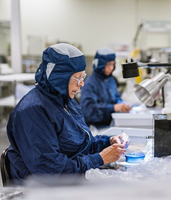Medical Device Manufacturing
INDUSTRY PERSPECTIVES
-
Risk-Based Analytical Method Selection In Cleaning Validation Using ASTM International Standards
This in-depth article describes risk in cleaning and provides a science- and risk-based framework for selecting analytical methods using ASTM International standards.
Here are practical tips to build validated, transparent, and auditable AI systems that align with GxP principles, paving the way for smarter and more resilient manufacturing processes.
Rapid prototyping has taken the medical device industry by storm, but there are pros and cons that device developers need to consider.
In the pharma/biotech and medical device industries, the audit trail is important to have for accountability, data integrity, repeatability to create an event for investigation, and regulatory compliance.
A cleaning validation professional must know how many process performance qualification runs are necessary. Here's how to go about demonstrating this with a high degree of assurance while minimizing the number of qualification runs.
WHITE PAPERS & CASE STUDIES
-
PolyPeel™ Peelable Polyester Heat Shrink Tubing
PET heat shrink is a strong barrier for medical devices, but difficult to remove. Peelable polyester heat shrink tubing is designed to overcome PET’s shortcomings.
Disc pumps enable quieter, smaller, and more precise wearable medical devices, improving patient comfort, measurement accuracy, and system reliability for innovative healthcare solutions.
Cleanroom micro molding ensures ultra-small components meet strict contamination and performance standards. As devices shrink and precision rises, controlled environments are essential for quality, reliability, and regulatory success.
Liquid Silicone Rubber (LSR) is redefining optical micro molding with superior durability, design flexibility, and thermal stability—empowering next-generation optical components where traditional thermoplastics fall short.
In micro-manufacturing, supplier choice significantly determines success. Explore how one company transformed a struggling production program into a 150-million-part success through trust, scalability, and true strategic partnership.
ABOUT MEDICAL DEVICE MANUFACTURING
Medical device manufacturing includes all aspects of the fabrication of a medical device, from designing a manufacturing process to scale-up to ongoing process improvements. It also includes the sterilization and packaging of a device for shipment.
Throughout the manufacturing process, medical device makers strive to be faster and more efficient, but they also wish to be responsible corporate citizens. Thus, manufacturing demands constant insight into renewable resources, sustainable materials, equipment that is more energy efficient, and methods to reduce waste creation. Solutions to these issues can come in the form of improved processes, technological advances in machines or equipment components, or safer/more reliable materials. The same principles apply to the packaging process.
Such "LEAN" manufacturing is considered an industry best practice: eliminating any activity, process, or material that does not add value for which a customer will pay.
Still, while speed and cost-savings are vital to successful manufacturing, quality control is of the utmost importance — particularly as medical device market demands shift toward a more value-driven landscape. Packaging validation, proving to the FDA that a product is sterile when it ships, is the final step.
Many medical device manufacturers excel in the ideation, concept, and prototyping phases of product development and outsource the production of components or entire devices to contract manufacturers. This is as true of established original equipment manufacturers (OEMs) as it is for mid-sized companies and startups. Contract manufacturers vary in size and expertise, as well — some comprise small, precise operations specializing in particular materials or components, while others are massive cleanroom facilities equipped for large-scale production.
LATEST HEADLINES
-
Accumold Achieves ISO 13485 Recertification, Reaffirming Commitment To Precision In Medical Micro Molding11/24/2025
Accumold secures ISO 13485 recertification, reinforcing its commitment to precision, quality, and reliability in micro molded components for demanding medical device applications worldwide.
-
Accumold To Exhibit At Medevice Silicon Valley, Showcasing Micro Molding Expertise For Cutting-Edge Medtech11/11/2025
Accumold will showcase its world-leading micro molding expertise at MEDevice Silicon Valley, Booth #1034, helping medtech innovators accelerate design, de-risk production, and achieve micron-level precision.
-
Accumold To Showcase Micro Molding Innovation At COMPAMED 202511/1/2025
Discover Accumold’s micro molding expertise at COMPAMED 2025, where ultra-precision, scalability, and DfMM capabilities showcase how next-generation medical devices are enabled through unmatched miniaturization and manufacturing reliability.
-
Discover Medbio's Medical Molding Expertise At MEDevice Silicon Valley 202510/23/2025
Visit Medbio at Booth #941, November 19–20, to explore custom injection molding and assembly solutions, supporting Class I–III devices with quality, compliance, and MedTech innovation.
-
Ensera Launches As New Brand Identity For SteriPack10/14/2025
New trading name reflects expanded expertise across design, manufacturing, assembly and packing for global pharma and medical device companies.
-
MTD Expands Metrology Capabilities To Accelerate Innovation9/29/2025
MTD Micro Molding expands its metrology capabilities with a cutting-edge optical 3D system, enabling faster, traceable, nanometer-precision measurements for complex micro medical components and tooling analysis.
-
Governor Shapiro Announces $20 Million Investment From B. Braun To Expand Medical Device Manufacturing In The Lehigh Valley, Creating 200 New Jobs9/18/2025
The project will create at least 200 new, full-time jobs over the next three years and retain 1,704 existing full-time positions. The Commonwealth is supporting the project with $1.5 million in state funding.
-
Accumold To Showcase Strategic Micro Molding Expertise At MEDevice Boston 20259/10/2025
Accumold will showcase its precision micro molding expertise at MEDevice Boston 2025, Booth 815, highlighting early design collaboration that accelerates innovation for next-generation medical devices and diagnostics.




